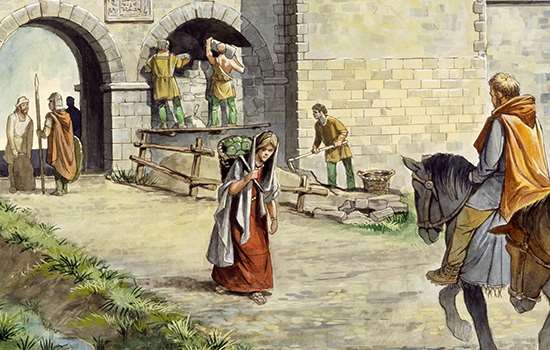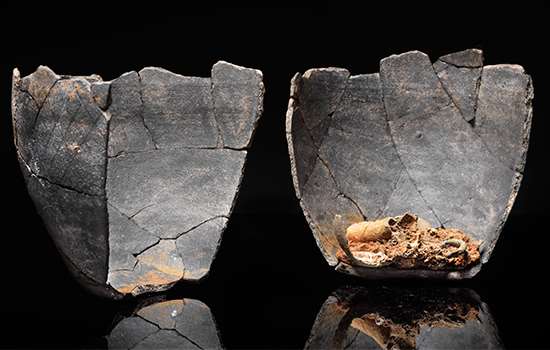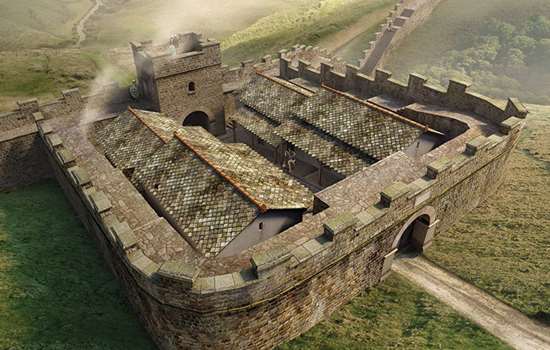The First Wall
The rarest feature of Hadrian’s Wall – the Turf Wall – was discovered just west of Birdoswald at Appletree.
In 1895, archaeologist Francis Haverfield discovered a portion of a wall made out of clods of earth, lying just to the south of stone remains of Hadrian’s Wall. He traced its line from Appletree, across Birdoswald Fort to Harrows Scar Milecastle. This was the first step in proving that a turf version of Hadrian’s Wall pre-dated the stone one west of the river Irthing.
Uniquely, around Birdoswald its stone replacement was placed to the north of the old Turf Wall, leaving its remains more readily accessible to archaeologists. Traces of the Turf Wall to the west of Birdoswald, including a turf milecastle, and its ditch, can still be spotted by keen-eyed visitors today.
Names Written In Stone
Soldiers from Dacia (modern-day Romania) were stationed at Birdoswald Fort from the 3rd century AD, and left their mark for us to read thousands of years later.
They inscribed stone altars used for religious rituals with the unit’s name (Cohors I Aelia Dacorum milliaria) and the names of their commanding officers, and also made proud records of the building work they carried out. These works included the addition of two huge storehouses for food and repairs to the east gate.
These inscriptions are just a small part of the evidence showing that the units garrisoned at Hadrian's Wall were originally recruited from across the Roman Empire. The Emperor Trajan conquered Dacia in AD 106 and made its soldiers join the Roman army. Although they were now part of the Roman Empire, Dacians still used names from their homeland, such as Decebalus, the name of the Dacian king defeated by Trajan.
Read more about the people of BirdoswaldA Thriving Community
In the late 20th and early 21st centuries, archaeologists discovered evidence of thriving settlements around Birdoswald Fort.
Using geophysical survey techniques (scanning beneath the ground), they found two large settlements sitting either side of the roads that lead out of the main east, west and south gates, together covering an area as big again as the fort itself. The surveys showed that Birdsowald Fort wasn’t just a military fort, but part of a thriving community. Uniquely on Hadrian’s Wall, some buildings were found north of the Wall, which suggests that the residents were not scared of what or who lay to the north.
No detailed excavations have been mounted to determine the precise form or function of the buildings, but these settlements would probably have been home to craftspeople, traders, veterans and the families of the serving soldiers.
Objects From Home
Excavations of the area south of the fort showed that in addition to the regiment from Dacia there was a second unit of soldiers living at Birdoswald.
Unlike the stone buildings inside the fort, where a cohort of Dacians lived, the buildings found here were made of wood. Archaeologists also discovered the tell-tale remnants of a distinctive type of pottery. Found also at Housesteads this is thought to have only been made by the natives of Frisia (northern Netherlands). A unit of Frisian soldiers occupied this area in the 3rd century AD.
It is uncertain why they were also based here – perhaps they had different skills from the Dacians. Their pottery has not been found inside the fort, so there was a strict divide between those outside and those inside.
Burial site
The cremation burial site at Birdoswald is the only one on Hadrian’s Wall to have been excavated. The existence of a cemetery at Birdoswald has been known about since 1959, when a farmer found two complete Roman burial pots. But in 2009 archaeologists decided to excavate to rescue the remains as they were at risk from erosion of the cliff on top of which Birdoswald sits.
The burials were analysed using the most up-to-date recording methods and research, and revealed the remains of not just men, as would be expected from a military base, but women and also a young child. The study of the urns and grave goods also revealed the practices and beliefs of those living on the frontier.
Military Drill Hall
Birdoswald has the only drill and exercise hall ever to have been found in a Roman auxiliary fort.
When excavating in preparation for installing new toilets in the 18th-century farmhouse at Birdoswald, archaeologists discovered the remains of a large stone support. The size, quality and positioning of the stonework indicated that the Roman building beneath the farmhouse was a large basilica – a high hall flanked by aisles, similar to the nave of a church.
The most likely explanation of the building is that it was a basilica excercitatoria (exercise hall). According to the Roman military author Vegetius, such halls were used for military training in wet or windy weather. Even Roman soldiers, it seems, had to take shelter from the British weather.
Those Who Stayed Behind
In the late 1980s, English Heritage archaeologists unearthed evidence that proved for the first time that the people of Birdsowald remained at the fort after the end of Roman Britain.
Roman rule over Britain officially ended in AD 410, when the Emperor Honorius abandoned Britain in the face of attacks on Rome. It was previously thought that the army left Britain, but the remains of timber buildings in use well into the 5th century AD showed that the garrison stayed at Birdsowald.
The most exciting discovery was the large ‘hall’ that sat partially on top of the ruins of the fort’s north granary. It is not known exactly what life was like at this time, but the building’s size and evidence that it had hearths imply that it was remarkably like the great feasting halls belonging to powerful kings described in the epic Anglo-Saxon poem Beowulf. Protected by the walls of the fort, perhaps a powerful local warrior used this hall as a seat of power to control the local area.
New Identities
In 1956, during work to clear vegetation from the Wall, this pin was found. It is made from copper alloy, with gilding on the surface. It has been dated to the 8th century and would have been worn as a dress pin. The hole in one side of the head would have allowed it to be linked to a chain, and so on to another pin.
This is one of a number of objects found in and around Birdoswald that indicate activity at the site after the end of the Roman period. Some of them are shown in the exhibition space at Birdoswald, such as a 6th-century Byzantine coin minted in Istanbul.
Explore More
-

The People of Birdoswald
Once sworn enemies of the empire, the Dacians became trusted protectors of its north-west frontier. Explore their story and learn more about the diverse cultures on Hadrian’s Wall.
-

Death and burial rites at Birdoswald
A rare excavation of burial urns found at Birdoswald has allowed researchers to examine the remains of those who lived and died at the fort. Discover what the new research reveals.
-

Birdoswald: History and Stories
Explore Birdoswald through time and learn about the community who travelled across the Empire and made the fort their home.
-

Hadrian’s Wall: History and Stories
Discover the histories, stories and mysteries associated with English Heritage’s Hadrian’s Wall sites.
